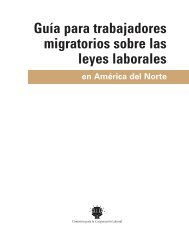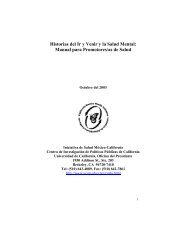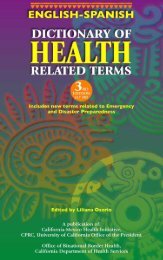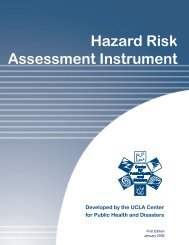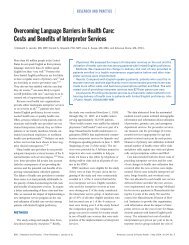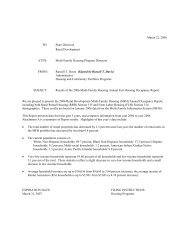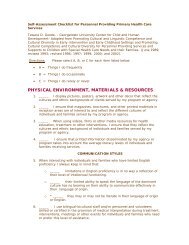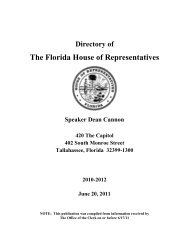Guide to Understanding Florida's FQHCs and 330 Expansion ...
Guide to Understanding Florida's FQHCs and 330 Expansion ...
Guide to Understanding Florida's FQHCs and 330 Expansion ...
Create successful ePaper yourself
Turn your PDF publications into a flip-book with our unique Google optimized e-Paper software.
organizations (PPO,) provider sponsored networks (PSN), minority physicians networks <strong>and</strong><br />
rural healthcare networks. Vendors will develop a variety of healthcare plans with unique sets of<br />
covered services <strong>to</strong> compete for enrollment. Florida proposes that Medicaid recipients, with the help<br />
of counselors, will use their state supplied premium <strong>to</strong> purchase a healthcare plan or “opt out” of<br />
Medicaid <strong>and</strong> use their premium <strong>to</strong> purchase private insurance, <strong>and</strong> enroll in a flexible spending<br />
account.<br />
Another important element in Florida’s Medicaid reform proposal is replacing the state’s current<br />
upper payment limit financing (UPL) with a $1 billion annual Low income pool” (LIP) fund <strong>to</strong><br />
pay for care provided <strong>to</strong> the uninsured. Prior <strong>to</strong> the development of the low income pool, only<br />
hospitals could participate in the UPL program, restricting any efforts <strong>to</strong> reduce the inappropriate<br />
use of emergency rooms. The new low income pool allows other providers of primary <strong>and</strong><br />
preventative care <strong>to</strong> benefit from the federal LIP funding. <strong>FQHCs</strong> will participate in the low income<br />
pool, along with an additional 80 hospitals that previously did not benefit from the UPL financing.<br />
The FQHC UPL funds will help divert the inappropriate use of emergency rooms by increasing the<br />
capacity of health centers <strong>to</strong> provide services for the uninsured, including increasing the number of<br />
hours that services are available, aiding the state in reducing access barriers <strong>to</strong> primary care for the<br />
uninsured.<br />
A quarter of the revenue that allows Florida’s <strong>FQHCs</strong> <strong>to</strong> keep their doors open comes from<br />
Medicaid. Changes <strong>to</strong> the program have serious implications for the survival of <strong>FQHCs</strong> <strong>and</strong> other<br />
safety net providers. If the state fails <strong>to</strong> provide recipients with sufficient funds <strong>to</strong> purchase<br />
adequate low-deductible insurance coverage, patients are likely <strong>to</strong> go <strong>to</strong> <strong>FQHCs</strong> when they have<br />
exhausted their coverage elsewhere or if they are unable <strong>to</strong> meet the cost sharing requirements of<br />
their plans. Under the new system <strong>FQHCs</strong> could potentially lose their current Medicaid patients <strong>to</strong><br />
other plans <strong>and</strong> receive them back as uninsured patients, losing a significant source of revenue <strong>and</strong><br />
jeopardizing their financial viability. Florida’s Medicaid reform proposal requires local plans <strong>to</strong><br />
make a “good faith effort” <strong>to</strong> include <strong>FQHCs</strong>, rural health clinics, <strong>and</strong> county health departments in<br />
their network. However, if a plan can demonstrate <strong>to</strong> the state <strong>and</strong> CMS that adequate capacity <strong>and</strong><br />
an appropriate range of services is available for vulnerable populations without contracting with<br />
<strong>FQHCs</strong>, rural health clinics <strong>and</strong> CHDs then the plan can be relieved of this requirement.<br />
Conclusion of Section Two<br />
Florida is a large <strong>and</strong> complex state that is home <strong>to</strong> a diverse population, including a number of<br />
“Special Populations” that face unique healthcare challenges. Our population is growing at a rapid<br />
pace. Increases in poverty <strong>and</strong> uninsurance rates exacerbate the need for affordable healthcare. Like<br />
other states, Florida needs <strong>to</strong> address disparities in healthcare based on race, ethnicity <strong>and</strong><br />
geographic fac<strong>to</strong>rs. Florida <strong>FQHCs</strong> can serve as a stable source of quality healthcare for low income<br />
Floridians. It is critical <strong>to</strong> the health of our state that the FQHC role as safety net providers be<br />
recognized <strong>and</strong> preserved under any new <strong>and</strong> evolving system.<br />
<strong>Underst<strong>and</strong>ing</strong> Florida <strong>FQHCs</strong> Copyright 2006 Page 23 ©




